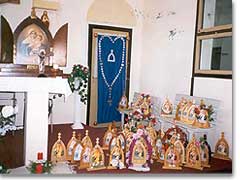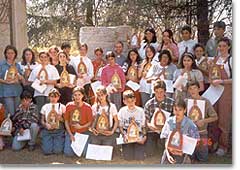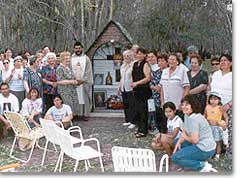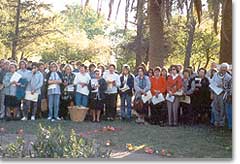 |
|
La Campaña – compromiso con el Padre y su misión The Campaign – committed to the Founder and his mission Die Kampagne – bereit für die Sendung des Gründers |
|
 |
|
Peregrinas de varias modalidades de la Campaña (Corrientes) Pilgrim MTA’s of the different modalities of the Campaign (Corrientes) Bilder der Pilgernden Gottesmutter der verschiedenen Modalitäten (Corrientes) |
|
 |
|
Misioneritos (Córdoba) Little missionaries (Córdoba) Kleine Missionare (Córdoba) |
|
 |
|
Ermita (San Nicolás) Wayside Shrine (San Nicolás) Bildstock (San Nicolás) |
|
 |
|
Procesión (Insel Apipé) Procession (Apipé Island) Prozession (Insel Apipé) |
|
 |
|
Rosario Iluminado Illuminated Rosary Lichter-Rosenkranz Fotos: Crivelli/CR Argentina © 2005 |
|
|
In March of 1997, Father Guillermo Carmona, Director of the Movement in Argentina, showed through the following article how the Rosary Campaign, one of the outstanding fruits of the 31st of May, is a real and original contribution to the New Evangelization. In the meanwhile, since the publication of this article, the number of Pilgrim MTA's have multiplied and they have also developed in diverse modalities, features, ways of insertion into parish life based on concrete experiences. This article along with the Document of Consensus Santa Maria 89 and the conferences of the International Encounter Santa Maria 2000, form part of the indispensable reflection about the mission of Schoenstatt as well as about the spirit of the Campaign, the "missionary aspect" of Schoenstatt.
Father Guillermo Carmona. Since the encounter with John Paul II in Haiti - in 1983 - until now, the Church in Latin America has especially felt motivated to a renewal of its pastoral and service to man. This global project, based on the commitment of Christians and on the strength of the Pentecostal Spirit, has been called "New Evangelization" (cfr. Message of the IV General Conference of the Latin American Episcopate, 12).
The Schoenstatt Movement has felt that it was summoned to assume this effort of the Church, making the expectations of the Holy Father its own: "The Church expects much from the lay persons who, with enthusiasm and evangelical effectiveness, operate through the new apostolic movements, that should be coordinated in the joint pastoral and that respond to the necessity of a greater presence in the faith in social life: (Inaugural talk of the Holy Father, 12th of October of 1992, n.27). It is season of new Advent (Redemptor hominis, 1) (Redeemer of Man, 1) a season of expectation.
Among the different groups of Schoenstatt, we find the "Schoenstatt Rosary Campaign". Through this writing, we want to show how the "Campaign makes an original contribution to the New Evangelization, while we wait for the "new springtime of Christian life" (TMA, 18 ) that John Paul II hopes for in the Great Jubilee of the year 2000.
1. The New Evangelization
The question that has occupied the Latin American Episcopal Conference in Santo Domingo has been to better profile what forms the New Evangelization. A definition is not offered, but rather a description of the task is given (crf. ib. nr. 25-30).
Five dimensions seem to be the most characteristic:
- The subject of the New Evangelization is for all the Church and not only a part of it. It is not only the hierarchy or the consecrated ones who are responsible, but rather all the people of God.
- Its objective - these are conclusions of Santo Domingo - to form persons and communities that are committed to their faith, who respond to challenges that are presented to them in different situations of their life (nr. ib.26).
- Those to be reached are all men, without distinction of social class, political option, life style, work, or profession.
- The content of the New Evangelization is Jesus Christ, a manifestation of the merciful and loyal love of the Father. It is about proclaiming - as affirmed in Evangelii Nuntiandi - "the name, doctrine, life, promises, reign, mystery of Jesus of Nazareth, Son of God" (Evangelii Nuntiandi, 22).
- This New Evangelization should be carried out with a new zeal, new
methods, and new Expressions:
a. New zeal. The conclusions of Santo Domingo speak of a "mystic or mystical": "an enthusiasm that cannot be contained in the task of announcing the Gospel" (Santo Domingo, 28).
b. New methods. New ways must be found. Awaken the imagination and creativity - two aspects that are explicitly mentioned in the Document, so that the apostolic endeavors will be more efficient (Santo Domingo, 29). Neither personal contact, nor, the testimony of life can be prevented - the presence of Christians with conviction in all places - an openness to the Holy Spirit, is the soul of every apostolate.
c. New expressions. It is not only of adjusting the language to the man of today, but to know how to use the pedagogy and contact points, so that everyone will have access to Jesus Christ. The Gospel should become " part of the culture", that it is nothing more than the reality of seriously assuming the consequences of the Incarnate Word.
2. The challenge of the New Evangelization for the Movements of the Church
It has been one of the constants of John Paul II's pontificate to support and to promote the apostolic Movements that have surged independence of the Church. In this way, he has permitted that the breath of the Holy Spirit penetrates with its rapid whirl to refresh the interior chambers: "Do not extinguish the the action of the Spirit, do not reject it prophecies, examine everything and keep what is good" (Tes. 5, 19-21). He has also protected these Movements from certain authoritarian tendencies of some leaders of the Church, urging in this way - as the Document of Puebla reads - that the competent authorities not only discern, but value the multiplicity and the variety of charismas that is shed on the members of the Church (cfr. Documento de Puebla, 688).
If we could perceive the advantages that the Movements have in respect to the New Evangelization (depending on each concrete case of the Movement) we should mention - for the moment - the following aspects:
a. They have been born to respond to situations of crisis: loneliness, aggression, fears, secularism, atheism, religious indifference, the desire for holiness in the midst of a threatening atmosphere, etc. These are precisely the challenges which face the New Evangelization.
b. The movements, the majority of which are of lay character, reach places where the "official Church" does not reach. Their protagonist character helps in the diffusion of the Message. And the Bishops insist on this: "The constant promotion of the laity is necessary, free of all clericalism, and without doing away with the intra ecclesia" (SD, 97).
c. They have a great conscience of solidarity and a strong prayer life. Faith that is shared helps to not diminish the commitment, to not stay midway nor to falter before the threats and the contrariness of a world that is absent of faith.
d. Their evangelical character can take them to a social and humanitarian commitment presenting the face of a Church that is accessible to those who have strayed for some reason from the official institution.
e. They are antidotes against the growth of sects. The advancement of these places the pastoral of the Church in jeopardy. If there are efforts to solve the problem, agents to carry them out are needed who will carry forth the new pastoral. It is necessary to place the person at the center, to promote community and a personal relationship with God. The Movements of the Church usually have suitable means to accomplish these goals. It will depend on the stimulus and the encouragement that they receive from the ecclesia itself (cfr. Inaugural Discourse of Santo Domingo, n. 12).
3. Three points of departure of Schoenstatt's contribution
The specific contribution of Schoenstatt to the New Evangelization must be seen within a triple point of reference:
a. Mary
Since Schoenstatt is a profoundly Marian Movement, it can play a decisive role within the New Evangelization in Latin America.
Mary is of great importance in the New Evangelization. She belongs to the Christian experience of the people of Latin America. She is part of the "own identity of the Latin people" (cfr. John Paul II; Zapopan, 2).There are people who do not actively participate in the Church but they have an access to the ecclesia through a Marian attachment. Marian piety perhaps attracts like no other aspect of the Latin "soul", and for that reason it can be a point of departure for a real Evangelization:
- the strong accent of human attachments,
- the filial character
- the element of family
Mary essentially helps to develop these three aspects of the Christian life (not only in Latin America!). She awakens an "evangelical instinct" (Document of Puebla, 285) to meet them:
1 Mary, sister of men and intercessor before her Son, knows how to bind attachments. The processions to pilgrimage places, as all Marian devotions, have gathered the people. She is the sign of "Ecclesia": "You can not speak about Church without Mary's presence" (Marialis Cultus, 28).
2 As Mary of Jesus Christ, She is also our mother, given to all men from the cross. She enlivens the filial heart that beats in each person, man or woman. From this point she helps us to cultivate a filial sentiment before God the Father, through her Son, Jesus Christ.
3 As a woman, She has a feminine presence: she creates a family atmosphere, she awakens the welcoming, to love and respect for life. She is the sacramental presence of the maternal traits of God. She a very profoundly human and a holy reality that arouses pleas of tenderness, sorrow and hope in the believers" (Document of Puebla, 291)
b. The conscience of instrumentality
As an "apostolic" Movement, Schoenstatt awakens a strong mission consciousness. Its members work in different apostolic tasks: within the Church - they assume ministries, services and functions, they coordinate base communities, etc. - and outwardly - they work in the family, the neighborhoods, and the social, educational, political realms and in the work place.
So that is mission consciousness does not deteriorate, the Movement cultivates a fundamental attitude: the "conscience of instrumentality". Each Christian is an instrument in the hands of God: through him. God makes him present, he manifests himself, he becomes transparent, and he orients, helps and leads.
c. Covenant spirituality
The nucleus of Schoenstatt spirituality is the Covenant of Love that God seals with man through Mary. The Covenant is the main idea of Salvation History. Schoenstatt assumes it by actualizing Baptism, which is the form in which the Christian is inserted into the salvific Covenant.
The source of the Covenant has to be found in the intercommunion of love in the Trinitarian soul. The Incarnation and Pascual Mystery of Jesus Christ gives us access to that Covenant: In Christ, we participate in the mystery of God, and we experience it especially through the sacraments.
The Covenant of Love that Schoenstatt seals with Mary leads us to Jesus Christ: "Per Mariam ad Christum" "Through Mary to Christ", was the proclamation that the Movement had at its beginning. And through Jesus, to the Father. There is no other way to reach God if not through Jesus.
This Covenant is not exhausted in the relationship of man with God but it leads to a communion among men and it is formed in daily life in the behavior of the allies: solidarity, honesty, service, justice, reconciliation, love of neighbor. It is deeply active and renewing.
4. The Campaign, an original contribution to the New Evangelization
On a certain occasion, Father Kentenich affirmed:
"Our priests, especially the younger generation, are looking for a new and modern pastoral method. Here it is .What Mr. Pozzobon does is the pastoral that we need. He gives Our Lady the chance to be active. What does Mr. Pozzobon do? He takes Our Lady wherever he possibly can and gives her the opportunity of doing the work...That is precisely what we have wanted and emphasized. "(Hero Today, Not Tomorrow, pp.27-29 ). In the work of John Pozzobon the words of Vincent Palloti become a reality, in a visible manner: She is great Missionary, She will work miracles".
What is this Campaign, how does it work, what does it offer concretely?
The initiator and the pioneer of the Campaign
John Luiz Pozzobon is the initiator of the "Schoenstatt Rosary Campaign" (Bibliography about Pozzobon: Father Esteban Uriburu, 140,000 kilometers walking with the Blessed Mother, 1985; Heroe today not tomorrow, 1988; I will continue with you, 1994)
Concept:
The campaign is a mission inserted in the Church, a way of modern pastoral with the specific objective of evangelizing families. It goes out to meet everyone, promoting the ideal of living Christian values. Its strength of irradiation lies in that it goes out from the Shrine and it reaches the people with their needs and preoccupations.
Since it is simple, it is within everyone's reach. It has as a support a solid spirituality and an efficient pedagogy. It has an agile organization, those who take the Pilgrim MTA - the coordinators - and those who receive it, get the feeling of being brothers and they can truly form communities.
The specific thing about the Campaign is the regular visit of the Schoenstatt Pilgrim MTA to families, schools, jails, hospices and hospitals. The main thing is the consecration of heart to the Blessed Mother.
The Campaign depicts three biblical scenes: the cross, when John receives Mary and takes her to his home; the visitation, when Mary arrives at the home as she did with the family of Elizabeth; and the Cenacle, when the apostles united in prayer with Mary, waited for the Spirit, to become apostles of the world.
A phrase of St. Vincent Palloti that expresses the evangelical factor of the Pilgrim MTA is: "She is the Great Missionary, She will work miracles".
The spirit of the Campaign
It is part of the Campaign to cultivate a close contact and collaboration with the parishes. The Pastor can in this way count on an extraordinary method of evangelization that draws families, promotes the sacramental life, and collaborates so that the parish will be a "community of communities and of Movements" (Santo Domingo, 58).
We could succinctly summarize it by saying that the Campaign consists of:
- Taking the image of Our Lady of Schoenstatt
- from the Shrine and in union with it
- to many men, especially families
- so that through the rosary, the Covenant of Love, information and catequesis is received,
- the Blessed Mother can act as the Great Missionary
- for the renewal of families, the Church and the world.
How the Campaign functions
Each Pilgrim MTA visits a group of approximately ten families staying in each house for three days. The visit of the Pilgrim MTA can also be organized in hospital, jails, schools, businesses, which have their own modalities. To initiate the work it is necessary for the pastor of the place to give his permission, as well as that of a competent authority.
The missionary (coordinator)
The person - or couple - who takes the Pilgrim MTA and becomes responsible for it is the coordinator. He seeks families who will receive it, he schedules the visits, trying - if possible - to schedule homes that are not far apart one from the other. This makes it easier for the Pilgrim MTA to travel and so a base community can be formed.
To fulfill his task, the coordinator receives formation and the necessary training. The "Diocesan Team Coordinator" is responsible for providing that training. It does not deal with something that is "technical", but he should also have a coherent spirit with what he does.
The coordinator assumes the commitment for the term of one year. This can be renewed as many times as he wants. This renewal is usually done in a proper celebration and is of importance for the interior attachment of the coordinator.
Those who receive the Pilgrim MTA commit to find a "place of honor" in their home, to pray the rosary, with some of the mysteries, or to say a prayer that is special to the family. They receive the Pilgrim MTA on the same days of each month.
The families receive the Pilgrim MTA with it own prayer, they read the notebook that accompanies the shrine which has information about the Campaign, the Parish, the Diocese or the Church. A simple paraliturgical ceremony can also be organized, this is also explained in the notebook.
The organization of the Campaign
The Campaign organizationally belongs to the Schoenstatt Movement. It has a diocesan and federal structure. There is a "team that is responsible for the campaign" in each diocese. Its organization is simple and agile. It is the task of this team to form the coordinators, plan diocesan encounters, and prepare material to be distributed and to resolve the problems that occur.
5. The evangelical framework of the Campaign
The experience of the past twelve years of work with the Campaign have signaled that a great concern of the New Evangelization can very well become concrete with the Campaign.
The Campaign gives a new zeal
It is not merely a pastoral method, but a "mystic" one. A strong apostolic conscience is awakened, there is an enthusiasm that cannot be "contained", and a commitment that makes the testimony credible. The Kentenich principle: "life enkindles life" causes the coordinator to nourish himself with his apostolic work.
The Campaign forms new expressions
The religiousness of the people is revitalized from within. In this way elitism is avoided and the catequesis takes a more universal slant:
1 In addition to the evangelical factor, the neighbors of a place usually build a wayside shrine, where the people gather to pray. In these twelve years of the Campaign (1984-1996) close to 400 wayside shrines have been built in Argentina (the number in 1997: more than a 1000). They are places of a supernatural presence, in the midst of a world loaded with profane or neutral signs.
2 The pilgrimage character of the people is manifested in the pilgrimages organized by the people of the Campaign, that "returns the Blessed Mother's visit", greeting her in her Shrines.
3 The Christian symbols - the cross, the medal, the coronation, and the images of saints - regain new dimensions
4 The sacramentals - such as the rosary, the enthronement of the image of Mary or of Jesus in the home, etc. - is transformed in a source of life and it changes attitudes and behaviors.
5 Liturgies and paraliturgies - Adoration, hours of "Cenacle" - regain a new meaning and are sources of life.
6 The Word of God has a new place to be proclaimed, explained, and valued.
The Campaign has no age limits: there are children who are coordinators (the little coordinators), among the youth ("the youth of the campaign") and the adults. All social classes are welcome: it has expanded among the poor, as well as the middle class and the wealthy. In this way the concern for society is enlivened. (Social Solicitude Rei, 41) without hurting the conscience of solidarity and fraternity.
All vital situations can be part of the Campaign: healthy people and the sick, free ones and those who are jailed, professors and students, clerical workers, workers and professional, couples and single people.
The Campaign has created new methods and recreated old ones
If we understand that the fundamental objective of the Campaign is the renewal of the family, we should conclude that the great method of the Campaign is to "announce with joy and conviction the good news about the family" (Familiaris Consortio, 86). To accomplish it, the following is stressed:
The personal character: the Pilgrim MTA arrives through the coordinator to the participant, generating an apostolic community and one of solidarity.
The testimonial character: it is not just about taking the Pilgrim MTA, but to commit oneself to the one which one takes; it is apostolate of "being" not only of "doing".
The ecclesial character: the information comes from the parish and it returns to the parish, questioning, motivating, and evangelizing.
The symbolic character: which is so much a part of the post-modern culture? The claim of decreasing reason has taken one to question the merely ideological and to awaken the value of symbols, music, dance, the subconscious.
The attachment to the place: the Pilgrim MTA's depart from the Shrine -Wayside Shrine, they arrive at the "little altar" in the home and they return to same Shrine from which they departed.
The integrating character that spans the natural and the supernatural, the social, the familial, welcoming that close by and those far away, associating work with family life, the intellectual, and affective and the volitional.
The character of defender of the faith, that preserves from the tragic influence of sects: where Mary is present, they are out of place.
How can you not find the two main concerns of the pastoral desired in Santo Domingo in the Campaign?:
"To promote a new missionary impulse that will discover the always real news of Jesus Christ, among which home visits and missions of the people are stressed" (SD,131)
Some final conclusions and perspectives
The spreading of the Campaign is not attributed to complicated means of the pastoral. It is in itself a simple method to evangelize. Originality must be sought in the "process of life", that it generates (Lebensvorgang), be it in the leaders, the coordinators, the participants.
When John Pozzobon initiated this Campaign, he felt that he should commit himself fully to her. Today, the Campaign lives of persons who assume it as a great challenge.
Perhaps one must always depend on, that the origin of the Campaign must be found in the Shrine. It is nourished from this source of life, of grace and of ideas. Its fruitfulness also depends on this source.
There are still some "subjects pending"
1 the challenge of the formation of the coordinators
2 to better profile the social characteristics of the Campaign (just as Pozzobon wanted)
3 to bring the pastors closer and to detonate a stronger commitment with the sacraments on the part of those who receive the Pilgrim MTA.
The training of the leaders - a task that we do not permanently meet, along with the publication and the pastoral reflection of what we do -would help so that from now to some years later we would be able to evaluate with more transparency its pastoral generosity. In that way we would be better able to perceive its fruits. For today, it continues being a great gift for the expansion of the faith, the awakening of the missionary and charitable consciousness within the Church and within Schoenstatt.
When Pope John Paul II affirms: "One thing is sure: each one is invited to do whatever is in their hands so that the great challenge of the year 2000 is not wasted, to which surely there is united a particular grace of the Lord for the Church and for all of humanity", we immediately think that the Campaign has been summoned to collaborate in the building of the time to come.
Translation: Celina M. Garza, Harlingen,TX, USA